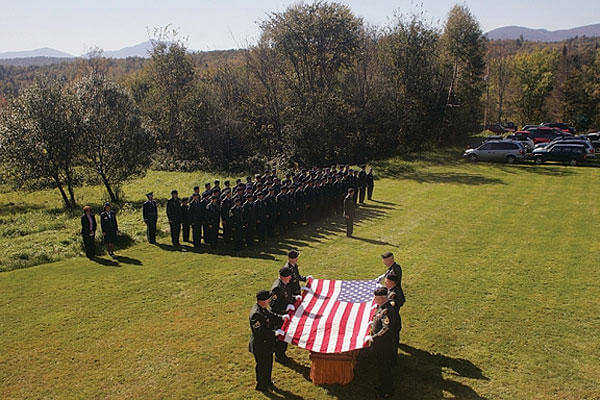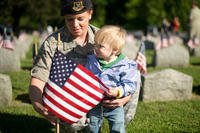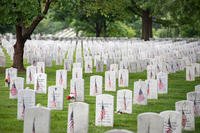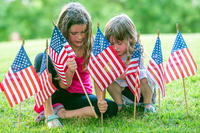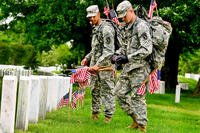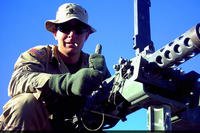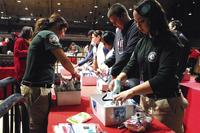I went to my first military funeral in November 2003. A local newspaper wrote that Jacob Fletcher, a 28-year-old private from Long Island, N.Y., was being buried with military honors at the national cemetery in Pinelawn. U.S. troops had already died in Iraq, and I believed deeply that their sacrifice was important, that their deaths should not be ignored.
The ceremony itself was brief. A lone bugler played Taps, an honor guard of seven soldiers fired their rifles into the air three times for a 21-gun salute, and the U.S. flag covering the casket was carefully folded and presented to Fletcher’s family. A military funeral has the feeling of having been designed while at war, under fire, and lasts at the gravesite about eight minutes.
Despite the sadness and grief all around me, I appreciated the simplicity and beauty of the event. At the time, U.S. military deaths in Iraq were not being covered by the national media. The story was about victory, and the speed of the conquest. It was there, beside the freshly dug dirt of Fletcher’s grave, that I knew this was for me more than another story. It was a commitment I had to make, a chance to bear witness.
In spring 2004, a magazine agreed to fund my travel expenses to attend 10 funerals across the country. Since the ceremonies were short and to some extent similar, I felt it was important to add geographic diversity. Every decent photograph can be considered a landscape, and I planned to rediscover my country through a schedule determined by grief and death. So one week I went to the desolate high plains of western Nebraska, the next to the desert of southern Arizona, then to the subdivisions of central Florida.
I was wrong. No matter how standardized the script of a military funeral, no two were the same. In the Berkshires of western Massachusetts, the police closed off the roads to all traffic but the funeral party, treating the death of a local kid like a national secret. In Arkansas, the father of a boy who had given away all his favorite belongings before he left for war, somehow knowing he would not be coming back, invited me over to their home for dinner.
Not feeling comfortable, not wanting to offend or intrude, and always remembering that the people being buried were so much more than another picture for a photo essay, there were some funerals where I never took the camera out of the bag. And then there were others where I became an official photographer of sorts, emailing images to the friends and family members of the soldiers. Everyone’s relationship to death is different.
From 2003 through 2006, I attended between 50 and 60 funerals – I never counted. Zachary Barr, a radio journalist, and I also visited 10 families across America that had lost a brother, father, son or husband in Iraq. Some grieving families wholeheartedly supported the war, and the Bush administration for starting it. A few were very angry with the government. But for most, their loved one’s death was deeply personal, beyond politics. It was from these families that I learned the most. They helped to show me what we have really lost – the incredible, priceless human sacrifice of war.
Where I live, in Brooklyn, Memorial Day is a three-day weekend, a time to take the cover off the above-ground pool in the backyard or to buy the first bag of charcoal for a barbeque along the East River. There is nothing wrong with that. After a long winter and a cold spring, the holiday is an unofficial celebration of the beginning of summer. But maybe I became a photographer because I was a visual person first. I’m fortunate to see the world in memories.
Memorial Day reminds me of the ghostly faces of the pair of barn owls that live on a cattle ranch managed by Jim and Pat Mracek on the edge of Hay Springs, Neb. I’d visit the owls in the barn each morning, and they would always silently sweep out onto the prairie. The Mraceks’ son, Cory, was killed in Iskandanriyah on Jan. 27, 2004. Or of sitting in the living room of a Kiowa elder in Apache, Okla., as he sang a traditional death song for his neighbor Joshua Ware, killed in Ubaydi on Nov. 16, 2005. I remember the muddy banks of the beautiful Wabash River, outside Independence, Ind., where Breanne Wilson ran with abandon, chasing her dogs. She was just a kid then. How old would she be now? Her father, Bryan, was killed in Anbar province on Dec. 1, 2004. It struck me then, and still does, how the names of these places, so familiar and so foreign, were connected. Independence and Anbar, worlds apart, briefly brought together in tragedy.
For me, Memorial Day has nothing to do with a single day, a single time of year, the end of spring and the beginning of summer. Every day is Memorial Day. I remember visiting Arlington National Cemetery on a freezing winter day just after Valentine’s Day. An icy crust had formed on top of the snow, and as I walked through the rows of new graves in Section 60, the area of the cemetery reserved for casualties of the war on terror, my boots fell through the ice, leaving a messy trail. On top of a single grave, a woman had left the imprint of a kiss, the red lipstick shining against the winter white.
